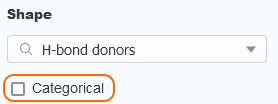June 5, 2023
CDD Vault Update (May 2023 #2): Displaying SuperAtoms in Ketcher, Visualization Enhancements, and API Parameters for GET Calls
Ketcher: Displaying SuperAtoms in Ketcher
Drawing SuperAtoms in Ketcher using the S-Group menu was announced in our April 24, 2023 Release Note. In Ketcher, users may use the [s] tool located on the left side of the structure editor to create SuperAtoms. This is handy for representing large portions of a structure using a text label. By right-clicking on these SuperAtoms, you can now Expand/Contract the group to show/hide the complete chemical representation. SuperAtoms/Abbreviations defined externally and pasted into the editor may also be expanded and contracted.
Visualization: Assign R-groups to Axes, Sort R-groups and a Categorical Checkbox
Create an R-group Decomposition plot, select your desired core, and the R1 and R2 groups can be assigned to the x-axis of a Scatter plot.
The R-group Decomposition plot can now be sorted by any parameter. As an example, if you sort your R-group plot by an activity value, all “good” molecules are clustered together.
When configuring plots and filtering data in Visualization, you may now force a parameter to be “Categorical” so individual numeric values are selected instead of a range.

API: Python Library for CDD Vault and New Parameters for GET Molecules, Batches and Readout_Rows
TheGET Readout_RowsAPI call accepts these new parameters:
- only_ids
- created_after
- created_before
- modified_after
- modified_before
Also, the “protocols” parameter is no longer required. Using these new parameters you can, for example, retrieve all new assay data without needing to specify particular protocols.
Example API call syntax and JSON are:
GET https://app.collaborativedrug.com/api/v1/vaults/<vault_id>/readout_rows{ "only_ids":true, "created_after":"2022-01-01", "created_before":"2023-01-01", "modified_after":"2022-01-01", "modified_before":"2023-01-01"}
The GET Batches API call returns all the Molecule-level details as well as the Batch information. Retrieving the Molecule details takes time, so to significantly speed things up and reduce data transfer you can now use the “only_molecule_ids” parameter to instruct the API call to return the full Batch details but leave the Molecule-level information out of the JSON results. The IDs of the Molecules are still included.
Example API call syntax and JSON are:GET https://app.collaborativedrug.com/api/v1/vaults/<vault_id>/batches{"created_after":"2023-05-20","only_molecule_ids": true}
Similarly, the GET Molecules API call returns the full Batch-level information (Batch-level data fields) associated with each Molecule returned. A new “only_batch_ids” parameter is now available to instruct the API call to leave the Batch-level data fields out of the JSON results. The IDs of the Batches belonging to the Molecules are still included.
Example API call syntax and JSON are:
GET https://app.collaborativedrug.com/api/v1/vaults/<vault_id>/molecules{"created_after":"2023-05-20","only_batch_ids": true}
Our partner, Workflow Informatics Corp. has published a Python SDK package to help streamline interaction with CDD Vault’s API. CDD is not maintaining this library but please check it out and provide feedback to our partner.
Other posts you might be interested in
View All Posts
CDD Blog
3 min
April 14, 2025
Let’s Talk Security - Why a Bug Bounty May Be More Valuable Than a Penetration Test
Read More
CDD Vault Updates
7 min
April 10, 2025
CDD Vault Update (April 2025): Biphasic Curve Fit, Import Parser Sections, Custom Calculation Functions, Generate Inventory Labels, Inventory Admin Permission
Read More
CDD Blog
9 min
April 8, 2025
Drug Discovery Industry Roundup with Barry Bunin — April 8th, 2025
Read More


